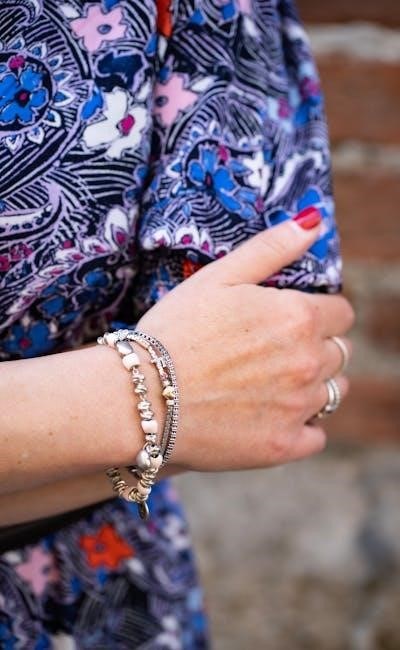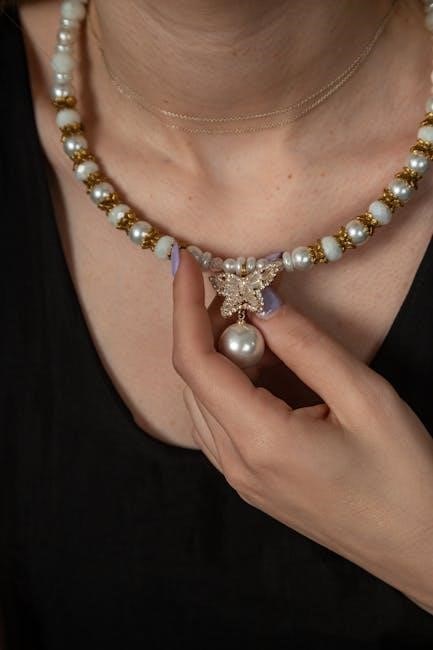This guide provides essential information on measuring wrist size, its importance, and applications in selecting accessories like watches and bracelets, while offering insights into health and sizing.
1.1 Importance of Wrist Measurements
Wrist measurements are crucial for determining proper fit in accessories like watches and bracelets, ensuring comfort and functionality. Accurate wrist size helps in selecting the right jewelry or watch band, avoiding resizing hassles. It also plays a role in health assessments, as wrist circumference can indicate bone density and metabolic rates. Understanding wrist size is essential for both practical applications and broader health implications, making it a key measurement in personal and medical contexts. By measuring wrist size, individuals can make informed decisions about accessories and monitor health indicators effectively. This guide emphasizes the significance of wrist measurements in daily life and wellness.
1.2 Purpose of the Guide
This guide aims to provide a comprehensive resource for understanding and measuring wrist size, catering to individuals seeking the perfect fit for watches, bracelets, and other accessories; It offers detailed instructions on measurement techniques, size charts, and factors influencing wrist size. The guide also explores health implications and practical applications, ensuring users can make informed decisions. By covering various aspects from measurement tools to health correlations, this guide serves as an essential tool for both personal use and professional applications, helping users achieve optimal fit and comfort in their accessories while gaining insights into broader health metrics. Its purpose is to empower users with knowledge for accurate and informed choices.

How to Measure Wrist Size
Measuring wrist size involves using a flexible tape measure or alternative tools to determine circumference accurately. The process ensures proper fit for watches, bracelets, and other accessories.
2.1 Tools Needed for Measurement
To measure wrist size accurately, you will need a flexible measuring tape, such as a tailor’s tape or a soft ruler. If a tape measure is unavailable, a piece of string or ribbon can be used as an alternative. Wrap the string around your wrist and mark the point where it overlaps, then measure the length using a ruler. For precision, ensure the tape or string is snug but not tight, and avoid measuring over clothing. Printable wrist measurement guides are also available online, providing a convenient tool for determining size; These tools help ensure accurate measurements for watches, bracelets, or health assessments.
2.2 Step-by-Step Measurement Process
Begin by locating the narrowest part of your wrist, typically just below the wrist bone. Wrap a flexible measuring tape snugly around this area, ensuring it is not too tight or loose. Align the tape measure so that it overlaps at the starting point. Take note of the circumference where the tape meets. For accuracy, keep your wrist straight and avoid twisting. If using a string, mark the overlap point and measure the length against a ruler. This process provides a precise measurement, essential for selecting the right size for watches, bracelets, or bangles. Proper alignment and snugness are key to obtaining an accurate reading.
2.3 Measuring Without a Tape Measure
If a tape measure is unavailable, use a string or flexible object like a paper strip. Wrap it around your wrist at the narrowest point, just below the wrist bone, ensuring a snug fit. Mark the point where the string overlaps with a pen or finger. Lay the marked string flat on a ruler to measure the length. Alternatively, print a wrist measurement guide from the internet, cut out the ruler, and wrap it around your wrist to determine your size. Ensure the ruler is printed to scale for accurate results. This method provides a reliable alternative for measuring wrist size without specialized tools, allowing you to find the perfect fit for watches or bracelets.
2.4 Understanding Inside vs. Outside Measurements
Understanding the difference between inside and outside wrist measurements is crucial for accurate sizing. Inside measurements refer to the inner circumference of the wrist, where a watch or bracelet rests snugly. This is typically measured just below the wrist bone, ensuring a comfortable fit without gaps. Outside measurements, on the other hand, account for the overall wrist size, including bone and muscle mass. For watches, the inside measurement is most relevant, while bracelets may require the outside to ensure they don’t slip off. Accurate differentiation between these measurements ensures proper fit and comfort for accessories like watches and bracelets, making it essential for selecting the right size.
Wrist Size Charts
This section provides standardized wrist size charts for men and women, correlating wrist measurements with height and categorizing sizes into tertiles for precise accessory fitting guidance.
3.1 Standard Wrist Size Chart for Men
For men, the standard wrist size chart categorizes measurements into Small, Medium, and Large. The average male wrist size is approximately 6.77 inches (17.2 cm). Small wrists typically measure less than 6.5 inches (16.5 cm), while Medium wrists range from 6.5 to 7 inches (16.5 to 17.8 cm). Large wrists exceed 7 inches (17.8 cm). These measurements are based on anthropometric data and are widely used to determine appropriate watch and bracelet sizes. The chart helps men choose accessories that fit comfortably, ensuring a proportions look. Understanding your wrist size is essential for selecting the right jewelry or timepiece, ensuring both comfort and style.
3.2 Standard Wrist Size Chart for Women
The standard wrist size chart for women categorizes measurements into Small, Medium, and Large. The average female wrist size is approximately 6.25 inches (15.9 cm). Small wrists typically measure less than 6 inches (15.2 cm), while Medium wrists range from 6 to 6.5 inches (15.2 to 16.5 cm). Large wrists exceed 6.5 inches (16.5 cm). These measurements are based on anthropometric data and are used to determine appropriate sizes for watches, bracelets, and bangles. The chart helps women choose accessories that fit comfortably, ensuring a balanced and stylish appearance. Understanding your wrist size is crucial for selecting the right jewelry or timepiece, tailored to your specific needs and preferences.
3.3 Wrist Size by Height
Wrist size can be correlated with height to determine body frame size. For individuals under 5’2″, a Small wrist is typically less than 5.5 inches (14 cm). Medium wrists are 5.5–5.75 inches (14–14.6 cm), and Large wrists exceed 5.75 inches (14.6 cm). For taller individuals, 5’2″–5’5″, Small wrists are under 5.75 inches (14.6 cm), Medium are 5.75–6 inches (14.6–15.2 cm), and Large exceed 6 inches (15.2 cm). This method helps estimate frame size for clothing or accessory sizing. Combining height and wrist measurements provides a more accurate assessment of body proportions, aiding in selecting appropriately sized items. This approach is particularly useful for determining if someone has a small, medium, or large frame based on their height and wrist circumference.
3.4 Tertiles for Wrist Size Categorization
Wrist size tertiles categorize individuals into three groups based on wrist circumference: small, medium, and large. These tertiles are derived from percentile rankings, where the 1st-33rd percentile is small, 34th-66th is medium, and 67th-99th is large. For men, small wrists are typically under 6.25 inches (15;8 cm), medium are 6.25–7 inches (15.8–17.8 cm), and large exceed 7 inches (17.8 cm). For women, small wrists are under 5.75 inches (14.6 cm), medium are 5;75–6 inches (14.6–15;2 cm), and large exceed 6 inches (15.2 cm). This method standardizes wrist size classification, aiding in health assessments, accessory sizing, and understanding body proportions. Tertiles provide a clear and objective way to determine wrist size categories for various applications.

Factors Affecting Wrist Size
Genetics, muscle mass, age, and health conditions influence wrist size, with bone density and metabolism also playing roles in determining circumference and overall wrist proportions.
4.1 Genetics and Hereditary Factors
Genetics significantly influence wrist size, as inherited traits determine bone structure and density. Families often share similar wrist proportions, highlighting hereditary patterns in skeletal frame. Research indicates that genetic factors account for approximately 50-70% of variability in wrist circumference. Bone growth receptors responsive to insulin and growth factors, as noted by Buzzetti, further link genetics to wrist size. Hereditary factors also affect muscle attachment points, impacting overall wrist measurements. These biological blueprints set the foundation for individual differences in wrist size, making genetics a primary determinant in wrist circumference and bone structure across populations and generations.
4.2 Muscle Mass and Activity Level
Muscle mass and activity level significantly impact wrist size, particularly in individuals with high physical engagement. Regular exercise, especially weight training, can increase wrist circumference due to muscle growth around the forearm and wrist area. Athletes and those with active lifestyles often exhibit larger wrist measurements compared to sedentary individuals. Additionally, repetitive strain or overuse in certain activities can lead to temporary swelling, further influencing wrist size. However, this muscle-related growth is typically superficial and does not affect bone structure, which remains primarily determined by genetics. Thus, while muscle mass contributes to variations in wrist circumference, it does not alter the underlying skeletal framework.
4.3 Age and Growth Factors
Age and growth significantly influence wrist size, particularly during developmental stages. Children and adolescents experience rapid wrist growth due to bone development, which slows down upon reaching physical maturity. On average, adult wrist size stabilizes, with minimal changes thereafter. However, natural aging can lead to slight reductions in wrist circumference due to bone density loss and muscle mass decrease. Factors such as puberty timing and overall health during growth periods also play a role in determining final wrist size. Understanding these age-related changes helps in accurately measuring and categorizing wrist sizes across different demographics, ensuring proper fit for accessories and medical assessments;
4.4 Health Conditions and Wrist Size
Certain health conditions can significantly impact wrist size and circumference. For instance, fractures or injuries may cause temporary swelling, affecting measurements. Chronic conditions like arthritis can lead to joint enlargement, altering wrist dimensions. Additionally, metabolic disorders and hormonal imbalances, such as those seen in diabetes or thyroid issues, can influence wrist circumference due to changes in fat and muscle distribution. Monitoring wrist size can also serve as an indicator for overall health, with extreme deviations potentially signaling underlying medical concerns. Understanding these correlations is crucial for accurate measurements and maintaining proper fit in accessories, as well as for early detection of health-related changes.

Choosing the Right Watch Size
Selecting the right watch size involves considering case diameter, band length, and personal comfort. Ensure proper fit by measuring wrist circumference and comparing it to size charts for accuracy.
5.1 Considerations for Watch Bands
When selecting a watch band, consider both style and functionality. Measure your wrist to determine the optimal band length, ensuring a snug yet comfortable fit. Adjustable bands offer versatility, while fixed-length bands provide a tailored look. Materials vary from leather to metal or silicone, each offering unique durability and aesthetic appeal. For a precise fit, add 0.5-1 cm to your wrist measurement to accommodate the watch case. Consider activities—wider bands suit casual wear, while slim bands are ideal for formal occasions. Ensure the buckle or clasp aligns with your wrist shape for added comfort. Properly fitted bands enhance both appearance and wearability, making them a crucial aspect of your timepiece choice.
5.2 Watch Case Size Recommendations
Watch case size should complement your wrist proportions for a balanced look. For smaller wrists (under 6 inches), cases between 36-40mm are ideal. Medium wrists (6-7 inches) suit 40-44mm cases, while larger wrists (over 7 inches) can accommodate 44-46mm or more. Consider the watch’s thickness for comfort, especially if you prefer a slim profile. Round or oval cases tend to fit most wrist shapes, but square or rectangular cases can offer a unique style. Ensure the case size aligns with your personal taste and lifestyle, whether formal or casual. Properly proportioned watches enhance both functionality and aesthetic appeal, making them a key element in your accessory choice.
5.3 Adjusting for Comfort and Fit
Ensuring a comfortable and proper fit is crucial when selecting a watch. After determining your wrist size, leave enough space to fit one finger between the watch band and your wrist for optimal comfort. Adjust the band to sit snugly without applying pressure, as tightness can cause discomfort. For watches with adjustable straps, use the micro-adjustment feature to fine-tune the fit. Consider the watch case thickness, as thicker models may require a slightly looser band for comfort. Regularly check and adjust the fit, especially in changing temperatures, to maintain a comfortable wear. Proper adjustments ensure the watch stays secure while allowing for a full range of motion and long-term wearability.
Selecting the Perfect Bracelet Size
Selecting the perfect bracelet size involves measuring your wrist accurately, adding 0.5 to 1 cm for comfort, and referencing standard size charts. Material flexibility affects fit.
6.1 Measuring for Bracelet Fit
Measuring for bracelet fit involves wrapping a flexible tape or string snugly around the thinnest part of your wrist. Mark the point where the ends meet, then measure against a ruler. Ensure the fit isn’t too tight, allowing enough space for comfort. For a more precise method, use a printable wrist measurement guide or a ruler printed to actual size. If a tape measure isn’t available, a strip of paper can be wrapped around the wrist, marked, and then measured. Adding 0.5 to 1 cm to the measured size ensures a comfortable fit without being overly loose.
6.2 Standard Bracelet Size Chart
A standard bracelet size chart categorizes wrist sizes into small, medium, and large. For women, small sizes typically range from 5.75 to 6 inches (14.6-15.2 cm), medium from 6 to 6.25 inches (15.2-15.8 cm), and large from 6.25 to 6.5 inches (15.8-16.5 cm). Men’s bracelets often have larger sizes, with small starting at 6.5 inches (16.5 cm), medium at 7 inches (17.8 cm), and large at 7.5 inches (19.1 cm). These measurements ensure a comfortable fit, with slight variations depending on the manufacturer. The chart provides a universal guide for selecting the right bracelet size based on wrist circumference, ensuring a proper fit without being too tight or loose.
6.3 Adding Comfort Space
Adding comfort space ensures your bracelet fits snugly without restricting movement. Measure your wrist circumference, then add 0.5 to 1 inch (1.3 to 2.5 cm) for a comfortable fit. For example, if your wrist measures 6 inches (15.2 cm), your bracelet size should be 6.5 to 7 inches (16;5 to 17.8 cm). This extra space allows for proper dexterity and ensures the bracelet doesn’t feel too tight. Some manufacturers recommend adding 1 cm for a more relaxed fit. Always consider the style of the bracelet, as thicker designs may require more comfort space. This step ensures your bracelet is both stylish and wearable, providing long-lasting comfort and satisfaction.
Bangle Size Guide
This section helps determine the perfect bangle size by measuring wrist circumference, ensuring a comfortable and stylish fit with options for small, medium, or large sizes.
7.1 Measuring for Bangle Fit
To measure your wrist for a bangle, wrap a flexible tape measure snugly around the widest part of your wrist, just below the wrist bone. Ensure the tape is not too tight or loose. Note the circumference in inches or centimeters. For a comfortable fit, add 0.5 inches (1.27 cm) to your measurement. If using a string, mark where it overlaps, then measure the length against a ruler. This method ensures the bangle will slide on easily while staying secure. Proper measurement is crucial for selecting the right size, whether for a delicate or statement piece.
7.2 Bangle Size Chart
Bangle sizes are categorized based on wrist circumference measurements. A small bangle typically fits wrists measuring 5.75 to 6 inches (14.6 to 15.2 cm), while a medium fits 6 to 6.25 inches (15.2 to 15.8 cm). Large bangles accommodate wrists from 6;25 to 6.5 inches (15.8 to 16.5 cm). These sizes ensure a comfortable fit, allowing the bangle to move slightly without being too loose. When selecting a bangle, compare your wrist measurement to the chart to find the ideal size for a secure yet comfortable wear. Proper sizing enhances both aesthetics and wearability, making it essential for choosing the right bangle.
7.3 Ensuring Proper Fit
Ensuring a proper fit for bangles involves careful measurement and consideration of personal comfort. After measuring your wrist circumference, compare it to the bangle size chart to select the appropriate size. A bangle should rest comfortably on the wrist without feeling too tight or slipping off easily. It’s recommended to add a small allowance, typically 0.5 to 1 cm, to your wrist measurement to accommodate movement and comfort. Additionally, some bangles may feature adjustable mechanisms, offering flexibility for different wrist sizes. Proper fit ensures the bangle remains secure and enhances the overall wearing experience, making it both functional and stylish.

Health Implications of Wrist Size
Wrist size can indicate bone density, metabolism, and overall health, with measurements used in medical diagnostics to assess conditions like insulin sensitivity and growth patterns.
8.1 Wrist Size and Bone Density
Wrist size is a key biomarker for assessing bone density, as it correlates with overall skeletal health. Smaller wrist circumferences may indicate lower bone density, increasing the risk of fractures and osteoporosis. Studies suggest that wrist measurements can reflect bone growth patterns, with insulin and growth factors influencing both bone density and wrist size. Average wrist sizes for men and women provide benchmarks for evaluating bone health. For example, a wrist size below average may signal lower bone density, while larger sizes often indicate stronger bone structures. Monitoring wrist size can aid in early detection of bone-related conditions, making it a valuable tool in health assessments.
8.2 Metabolism and Wrist Circumference
Research indicates a link between wrist circumference and metabolic factors, as wrist size reflects bone and muscle mass. Larger wrists often correlate with higher metabolism due to greater muscle mass. This connection is tied to insulin receptors in bone tissue, influencing growth factors. Average wrist sizes vary by gender, with men typically having larger measurements. Monitoring wrist size can provide insights into metabolic health, aiding in personalized fitness and dietary plans. Understanding this relationship helps in tailoring strategies to optimize metabolic function and overall well-being, making wrist measurements a valuable health indicator beyond accessory sizing.
8.3 Medical Uses of Wrist Measurements
Wrist measurements serve as a valuable diagnostic tool in medicine. They are used to assess bone density, particularly in conditions like osteoporosis, where wrist fractures are common. Additionally, wrist circumference helps determine body frame size, aiding in nutritional assessments and metabolic studies. In pediatrics, wrist size is measured to monitor growth patterns and detect potential developmental issues. Some studies also link wrist size to insulin sensitivity, as bone tissue contains insulin receptors. Overall, wrist measurements provide critical data for various medical evaluations, making them a non-invasive yet effective diagnostic resource.

Additional Measurement Guides
Explore supplementary tools and resources for precise wrist measurements, including printable guides, manufacturer-specific charts, and innovative technologies shaping the future of wrist sizing.
9.1 Printable Wrist Measurement Tools
Printable wrist measurement tools are readily available online, offering a convenient way to measure your wrist size without a tape measure. These tools often include downloadable rulers or charts that you can print and use to wrap around your wrist. Ensure the print settings are accurate to maintain scale; Simply cut out the ruler, wrap it snugly around your wrist at the widest point, and read the measurement where the ends meet. This method provides precise sizing for watches, bracelets, or other accessories. For comfort, add 0.5 to 1 cm to your measured size. Printable guides are easy to use and ensure accurate results, making them ideal for anyone needing to determine their wrist size at home.
9.2 Manufacturer-Specific Sizing
Manufacturer-specific sizing provides tailored guidelines for wrist measurements, ensuring a precise fit for products like watches and bracelets. Many brands, such as Apple, offer detailed size charts to help customers choose the right fit. For example, Apple provides metric-based sizing for its watch bands, catering to various wrist circumferences. Some manufacturers include half sizes or adjustable options to accommodate different preferences. These guides often align with standard sizing charts but may vary slightly based on the product’s design. Always refer to the manufacturer’s specific sizing chart for the most accurate measurement, as they may have unique recommendations for their products. This ensures optimal comfort and proper fit, tailored to the brand’s design specifications.
9.3 Future of Wrist Sizing Technology
Advancements in technology are revolutionizing wrist sizing, offering innovative solutions for precise measurements. AI-powered tools and 3D scanning are emerging as future standards, enabling accurate wrist circumference calculations without physical tapes. These technologies allow for personalized sizing recommendations, ensuring a perfect fit for watches, bracelets, and other accessories. Additionally, augmented reality (AR) apps are being developed to visualize how products will look on your wrist before purchase. Printable guides and digital rulers are also gaining popularity, making self-measurement more accessible. As these technologies evolve, they promise to simplify the sizing process, reduce errors, and enhance the overall shopping experience for consumers seeking the ideal fit for their wrist accessories.


